SAY IT WITH SAILORS
The flight deck of an aircraft carrier is perhaps the most dangerous place on earth to work. The Navy ratings who work there risk death in any number of ways—propeller strikes, engine intake ingestion, ordnance explosion, fuel fire, arrestor cables removing limbs, aircraft losing control and on and on. Every few minutes a 35,000 pound airplane literally crashes to the deck, airplanes are moving, propeller discs are threatening decapitation or de-limbing. People are everywhere. Flame, heat, deafening noise, fumes, toxins and danger are omnipresent. On top of all this are layered high winds, driving rain, a heaving deck and even the dark of night. It’s not the place to be if you are preoccupied by something other than the one part you have in this choreographed mayhem. It’s not the place to be if you are not aware of your surroundings.
So why, then, is it that the aircraft carrier’s flight deck can also become a thousand foot long, thousand sailor-strong, sentimental Hallmark greeting card? How can the most dangerous working environment also be the same place that a crew can send a message to a little boy dying of cancer, or birthday greetings to a Queen, or even just letting their mothers know they are thinking of them? I am speaking of the long-entrenched and truly weird practice of the aircraft carrier spell-out. Tim Dubé, military historian and former Navy cadet, explains the history of the spell-out: “This is an evolution of the custom of ‘manning the rails,’ itself an evolution of ‘manning the yards’ when sailors would climb the masts and position themselves along the spars or yards to render honours. It’s also done as a form of honour when entering a harbour to show no hostile intent—if you are manning the rails, you can’t be manning the guns. With aircraft carriers not really having rails, it would make sense to ‘say it with sailors,’ particularly if there was a bridge to pass under like the Golden Gate Bridge at San Francisco.”
The art of arranging large groups of sailors on the deck of an aircraft carrier is a practice long entrenched in the world of carrier operations. It is not known when this practice began, but a recent article in the Smithsonian’s Air & Space website suggested it may have started around the end of the Second World War. To be fair, they admitted it may have been earlier, but they were not sure. In my quest to find photographs of aircraft carrier flight deck spell-outs, I came across one photograph of the USS Lexington (CV-2) with her decks cleared of aircraft and a few hundred of her sailors turned out in dress whites and lined up quite artistically to spell-out the word NAVY. I probably will never know if this is the first example of a spell-out on a carrier deck, but the date is nearly ten years before the end of the war—1936 to be exact. The early date and the fact that they are spelling out perhaps the most simple of all words a navy crew could spell (NAVY) leads me to postulate that this may be one of the first deck spell-outs.
This is the earliest image I was able to find on the internet of an aircraft carrier carrying out a “flight deck spell-out.” Here, USS Lexington (CV-2), the first of the Lexington-class carriers, spells out NAVY—the most basic of words known to the United States Navy. It is possible, because of the simplicity of the message and the early date—17 September 1936—that we are looking at one of the first, if not the first, examples of the flight deck spell-out. Lexington is dead in the water off Long Beach, California. Photo: U.S. Naval Historical Center Photograph (# NH 67420) via navsource.org
The practice has come a long way since then. Today, it is a tradition that every carrier in the US Navy, and indeed in most aircraft carrier-equipped navies of the world, carries out. The first time it was thought of, I can imagine the Captain of the ship (let’s just say it was Lexington) thinking to himself, “I’ve got a floating parade ground 888 feet long and 107 feet wide. I have 2,800 bored sailors and airmen. I have a ship’s photographer and any number of aircraft that can climb above this deck. What can I do to create a photo that will get attention for the Lady Lex, the Navy and my crew?” My guess is it went something like that but now, nearly 80 years later, it is a tradition practiced by every crew of every aircraft carrier in every navy. Even the submariners are doing it... but one can imagine the limitations a submarine forces on creativity. Not so the carrier.
In the 1930s, as it still is today, the aircraft carrier was the height of technology, a magnet for the press, politicians, the curious, the young ladies and the young men of America. Just as soon as the first flight deck spell-out photo was taken, there is no doubt that it appeared in Navy magazines like “All Hands” and was a huge hit with local and national newspapers. Copying the idea was guaranteed to happen. By war’s end, carriers returning home were sending flight deck spell-out messages to their home ports or new ports of call.
My earliest memory of seeing a carrier flight deck spell-out was the now famous image of America’s first nuclear-powered carrier and her attendant nuclear powered task force steaming together at high speed across the ocean with the massive deck of USS Enterprise hosting a thousand or more sailors in brilliant white uniforms formed up to spell out E=mc2, the famous mass-energy equivalence formula, first proposed by Albert Einstein and considered a fundamental formula of the Nuclear Age. Alongside steamed two other ships of the line that were also powered by the atom—USS Long Beach and USS Bainbridge. The ships were demonstrating the capabilities on the new Navy by circumnavigating the planet without refuelling. Enterprise’s deck was immense, the aircraft—Vigilantes, Crusaders and Skyhawks—were all arranged in an artistic arrowhead design. The formation of the letters and number was perfection. The sun was shining. It blew my mind.
Over the past few months, I had been researching a couple of stories about aircraft carriers and began to come across many photographs of this strangely compelling practice of getting ship’s crews to form letters on the decks to send messages to people on shore. I started collecting them in a folder. Then I came across a page on Wikipedia where someone had collected scores of these photographs in one place, many of which I had in my folder. These photos also had US Navy press release-style captions attached, indicating that the media or public affairs people of the US Navy often got involved in these spell-outs... at least after the fact.
I also went repeatedly to a site called navsource.org, an excellent unofficial website which has collected statistics, cruise logs, photographs and anecdotes of nearly every ship ever to sail with the United States Navy. It is an astonishing collection of information and images and certainly one of the better, if not the best, site of this type I have found. I highly recommend a visit to the site, as it will draw you in for hours on end.
Scouring the entries for every aircraft carrier, I found many fine examples of the spell-out. I also noticed a few things. Escort carriers rarely were the canvas for a spell-out. Spell-outs on decks devoid of aircraft are not nearly as impressive as ones with aircraft. Some were exquisitely perfect, while others were remarkably sloppy. Some carriers were more active in the practice than others. The one thing that was common to all of these images was the clear message of pride in one’s ship and one’s navy.
Here now, for your enjoyment, are only some of the many photographs of aircraft carrier spell-outs I was able to discover over the past year. Every day I find others, and perhaps this can be the repository for as many as people can find. If you have other examples and would like them added to this story, send me a shot (700 pixel wide minimum) and a caption that tells what ship, where, when and possibly why and I will endeavour to add them.
There is an old marketing slogan used by florists worldwide that has been in use for years: “Say it with Flowers!” The carrier-equipped navies of the world have a better way to express sympathy, love, admiration, pride, patriotism and commemoration—they SAY IT WITH SAILORS!
Dave O’Malley, with thanks to Navsource.org and Kevin Nesdoly
The Port Of Call Shout-Out
For me, the greatest and most powerful of the great carrier flight deck spell-outs are those that give a massive shout-out to the ports of call they are arriving at or departing from. They are crowd favourites indeed. Like a rock star who shouts out “Hey Ottawa! We’re happy to be here tonight!” or “Hey Des Moines! Those Iowa girls are the cutest!” or “What’s up Green Bay, how about them Packers?” a carrier shout-out is never interpreted as manipulative and is always embraced by the community. Often the carrier creates the spell-out while approaching the city, passing under her bridges, below her lofty buildings. This is designed to get as much attention as possible... perhaps to get the word out to the pretty girls.
The ship usually puts up their own aircraft or helicopter, but sometimes newspaper photographers will take their own photographs from a bridge or high point. Regardless, the photographs are soon to appear in the port’s daily newspapers and, more often than not, are picked up in others across the country.
Here, starting with some good old hometown Canadian shout-outs, are some of the finest I could find on God’s gift to the curious—the internet.
When I started searching for aircraft carrier flight deck spell-outs, I was hoping to find a few that related to Canada. The Royal Canadian Navy operated only three carriers after the Second World War—Warrior, Magnificent and Bonaventure. While I found a couple of deck spell-outs on HMCS Bonaventure, I would also have to rely on American carriers for some Canadian content. Here USS Coral Sea (CV-43) pays a friendly visit to Vancouver, British Columbia in 1960, shortly after her recommissioning, and her crew makes us proud by spelling out a shout-out to their neighbours from the north. Photo: US Navy and usscoralsea.net
Related Stories
Click on image
I added this image of the same deck spell-out of USS Coral Sea in Vancouver to illustrate why 90% of the photographs in this story are taken from the port side of the carrier—the island superstructure blocks out the message, making for a poor photograph. Photo: US Navy and usscoralsea.net
USS Valley Forge (CVS-45) pays a visit to Halifax, Nova Scotia, with her crew lined up in navy blue uniforms and white gob hats spelling out “HELLO HALIFAX” on her flight deck, 10 July 1959. Valley Forge, flying the flag of Rear Admiral John S. Thach (creator of the Thach Weave, a combat flight formation that could counter enemy fighters of superior performance, and later the big blue blanket, an aerial defense against Kamikaze attacks), was accompanied by the rest of Task Force ALFA, including seven destroyers and two submarines. Altogether, about 4,000 US Navy sailors were in Halifax for the six-day visit. The bars down by the waterfront must have been hopping during those six days. Photo: US Navy via history.navy.mil
In the summer of 1962, aircraft carrier USS Intrepid (CVS-11) sailed up the St. Lawrence River and paid a port visit to La Belle Ville de Québec. Certainly the young sailors aboard must have enjoyed this most beautiful of all Canadian cities and its beautiful girls. On leaving, most of her crew turned out on deck to spell out MERCI QUÉBEC—even remembering to add the “accent aigu” over the first E of Québec. On deck are aircraft of Carrier Anti-Submarine Air Group 56 (CVSG-56). You can bet this photo was in Québec’s newspapers the next day! Photo: US Navy
Aboard the escort carrier USS Attu (CVE-102) members of her crew and perhaps Marines spell out an abbreviated greeting to the Fourth Marine Division as the ship enters San Diego Harbor in October of 1945 as part of the massive troop repatriation project called Operation MAGIC CARPET. In this complex logistical operation, US Navy ships (transport and combat units) brought home more than 3 million American troops and personnel from the European and Pacific Theatres by the end of March, 1946. Altogether, seven US Navy escort carriers were employed to bring home the more than 11,000 members of the Fourth Marine Division, who were veterans of many Pacific battles including Iwo Jima and Saipan and who were destined for demobilization at Camp Pendleton near San Diego, California. Photo: NAS San Diego
In 1951, following USS Bataan's reactivation for duty in Korea, the crew spells out its proud name. She has her Second World War configuration of four smoke stacks, but in the following photo, Bataan has been converted to a two-stack layout. Photo via BataanCVL29 Association
One of the more emotional flight deck spell-outs found in my search. The light aircraft carrier USS Bataan (CVL-29), photographed on 22 May 1953, as she was en route to Naval Air Station San Diego, California, following a deployment to Korean waters. Note the crew paraded on the flight deck spelling out the word “HOME” and an arrow pointing over her bow. The aircraft on deck include 19 Grumman AF Guardian anti-submarine planes and a solitary Vought F4U Corsair fighter (parked amidships on the starboard side). Text: Wikipedia, photo: US Navy
The Essex-class carrier USS Tarawa (CV-40) uses every inch of her “long hull” flight deck to spell out a greeting to the state of Connecticut in July of 1951. She is likely running down Long Island Sound and about to pay a visit to a naval base such as New London or Groton. Tarawa was named after the horrific Battle of Tarawa in the Second World War where US Marines assaulted and eventually defeated the Japanese. Photo: US Navy
While working from Pensacola, Florida as a training aircraft carrier, USS Monterey visited New Orleans, likely on more than one occasion. Here, 700 members of her crew in dress whites line up on her cleared deck to spell out a greeting to New Orleans, LA. USS Monterey (CV-26) was an Independence-class light aircraft carrier named after two previous ships of the line and the city of Monterey, California, captured during the Mexican War by a landing force of 250 Marines and bluejackets. As mentioned before, many carriers were named after American battle victories, preferably after those won by the Navy or the Marines. Monterey would end her career as an aircraft transport, carrying aircraft on her deck for delivery to overseas deployments and the like. Photo: US Navy via navsource.org
USS Franklin D. Roosevelt (Swanky Franky, Rosie or sometimes Foo de Roo) arrives off the coast of Nice, France in October of 1951 and offers up a salute: VIVE LA FRANCE for all the beautiful French girls. I can’t think of a nicer (pun intended) port to call at than the beautiful city on the French Riviera. Photo: US Navy
USS Hancock (CV-19), known as Hanna to her crew, quietly glides into San Francisco Bay, happy to be back in “OUR TOWN.” After a long cruise, carrier crews are grateful for the return to their families. For folks in San Francisco, the sentiment displayed by this spell-out must have been particularly warming. Returning ships were often photographed by the press from the Golden Gate Bridge—the likely location of this photographer. The crew is turned out in navy blue with white caps which makes the letters seem to float above the deck. Photo: U.S. Naval Historical Center
In a rather rough looking Pacific Ocean, USS Bon Homme Richard, the “Bonny Dick,” sends her crew out to spell a greeting to her home port of San Diego, California after her return from her 1962–63 Western Pacific Cruise. Photo: US Navy
In 1992, the United States Navy was pulling out of their Subic Bay base in the Philippines. One of the last ships to leave was the carrier USS Independence (CV-62) as the US Navy relinquished control to the Philippines. Crew members stand on deck, using the angled flight deck lines to line up their goodbye message: “FAREWELL SUBIC.” Photo: US Navy
It’s Fleet Week in NYC and USS Kearsarge, an Amphibious Assault Ship, steams off the brackish water of the Hudson River with a greeting for the next port of call—New York City. Some serious fun lies ahead for the crew. Note that the entire perimeter of the Kearsarge flight deck is lined with sailors alternately dressed in blue or white. Nice touch Kearsarge! Photo: US Navy
The USS Kearsarge, an Amphibious Assault Ship, steams off the brackish water of the Hudson River with a greeting for the next port of call—New York City. A US Navy press release tells the story: New York Harbor (May 24, 2006)—Sailors spell-out the message “I Love New York” on the flight deck aboard the amphibious assault ship USS Kearsarge (LHD 3) as they enter the harbor for Fleet Week New York City 2006. Fleet Week has been sponsored by New York City since 1984 in celebration of the United States sea service. The annual event also provides an opportunity for citizens of New York City and the surrounding Tri-State area to meet Sailors and Marines, as well as witness first-hand the latest capabilities of today’s Navy and Marine Corps team. Fleet Week includes dozens of military demonstrations and displays, including public tours of many of the participating ships. Photo: US Navy
In 1955, just weeks after her massive refit at the Puget Sound Naval Ship Yard in Washington, USS Shangri-La paid a visit to San Francisco en route to San Diego. While passing under the Golden Gate Bridge, her crew spelled out the words “HELLO BAY AREA” for the assembled photographers. She docked at Naval Air Station Alameda on the Oakland side of the bay. During her refit, she received the first structurally angled flight deck in the US Navy, as well as other improvements which made her, for the moment, the most modern carrier in the fleet, if not the world. Photo: UP Telephoto via Utah Daily Herald
In April of 1967, USS Bennington visited Sydney, Australia and offered up this accented greeting to the Diggers of the Land Down Under. For sailors touring the Pacific and the Far East, the most desirable port of call is Sydney or one of the big coastal cities of Australia. Photo: via uss-bennington.org
USS Hancock (CV-19), an Essex-class long hull carrier, was named after two previous ships of the US Navy, both sailing vessels named for John Hancock, president of the Second Continental Congress and first governor of the Commonwealth of Massachusetts. Here, two days before entering the harbour at Sydney, Australia, her crew stands to on deck to spell out the name of her next port of call. There is no doubt that this photograph was supplied to newspapers in Sydney as a goodwill image, something which likely made their welcome even warmer. Hanna was moored at Sydney in May of 1971 during one of her Vietnam cruises. Photo: US Navy via navsource.org and Robert M. Cieri
USS Abraham Lincoln (CVN-72), heading into her future home port, makes an effort after a cruise to give a shout-out to the community by spelling out EVERETT 96 on her flight deck and smartly arranging the F-14 and F-18 aircraft of her air group. The photo was taken in 1994, but she knew she would be home-porting at Everett, Washington in 1996. At the time, her home was Naval Air Station Alameda in Oakland, California. Photo: US Navy
In the summer of 1960, USS Wasp (CVS-18) sailed for the South Atlantic to offer assistance when fighting broke out in the newly independent Congo. She operated in support of the United Nations airlift and is seen here coming back from Dakar, Senegal in French West Africa on 29 July 1960. Photo: U.S. Navy via Navsource.org
The U.S. aircraft carrier USS Antietam (CVS-36), The Flying A, is seen arriving off Mayport, Florida, as the new training carrier in 1957. The crew is forming “Hi JAX” with a navy anchor on deck to greet the training base Naval Air Station Jacksonville, Florida. The Gearing-class destroyer USS Forrest Royal (DD-872) is steaming alongside and being refuelled. Antietam was named for the Battle of Antietam, the first battle of the American Civil War to be fought on Union or Northern soil—near Sharpsburg, Maryland.
The aircraft carrier USS Forrestal (CV-59) is accompanied by New York City tug boats as she passes under the Verrazano Narrows Bridge on her approach to New York City in 1989 on the occasion of Fleet Week. On her forward flight deck crew members spell “WE LOVE (Heart) NY.” The Forrestal was named after James Vincent Forrestal (1892–1949), the first Under Secretary of the Navy and a First World War naval aviator. As I write this, Forrestal is in Brownsville, Texas being broken up and recycled. Photo: US Navy
We Speak Your Language.
Not all spell-outs are written in the alphabet or language that we Westerners think is the only one. In fact, if you want your 1,000 sailor message to be understood in Yokosuka, Athens or Brunsbüttel Roads, you best form it up in the language and even the alphabet of the girls you want to impress. Sometimes, you want to transliterate the message so that both sides can understand what is being said... SAYONARA for instance was used a number of times by carriers heading home from duty in Japanese waters. And then, if you happen to be a Chinese or Indian aircraft carrier crew... spell it your way!
In early 1960, the crew of the Essex-class aircraft carrier USS Yorktown (CVS-10) form Japanese characters reading “HELLO JAPAN” as she arrives in Japanese waters to commence another tour with the US Seventh Fleet. The transliteration of the Japanese characters is: “HaRo-NiHon.” Photo: US Navy
One of the favourite greetings in a language other than English seems to be the Hawaiian greeting “Aloha” with several examples shown in this story. The Australian carrier HMAS Melbourne (R21) is seen here moored at Pearl Harbor, Hawaii, her crew spelling out “Aloha” on her flight deck in cursive script. It is rare indeed to find examples of a deck spell-out in lower case letters. Photo: US Navy
A nice shot of USS Essex (CVS-9) and her accompanying destroyers, USS Miller (left) and USS Wadleigh of US Navy Task Group 83.3, tied up at the piers of St. Pauli Landungsbrücken, part of the harbour facilities at Hamburg, Germany. Soon the ships will be getting up steam to leave out the Elbe River and the North Sea. The crew has been mustered on deck to spell out “TSCHÜSS”—German for Good Bye. The date was 1962, at the very end of her “People to People” cruise to Northern Europe with ports of call in Rotterdam, Hamburg, and Greenock, Scotland. During the Hamburg visit, over one million visitors toured Essex. During her departure, Essex almost ran aground in the shallow Elbe River. Photo: US Navy
On the People to People tour of late 1961–early 1962, USS Essex also visited Rotterdam. Here she is gliding down the Maas River in the company of her escort destroyers. As Christmas was upon them, the members of the crew stand on deck and spell out GOEDE KERST—Merry Christmas in Dutch. It’s impressive if you can actually identify a font used in a spell-out. In this case, it’s the same as the one they used in the previous photograph—Eurostyle Light. Photo: US Navy
On 25 April 1957, the Essex-class long hull carrier USS Lake Champlain (CVA-39) is photographed with a special message to the people of Greece as she passes en route to join elements of the fleet at the scene of tension in the Middle East. The task force would cruise in the vicinity of Lebanon and back Jordan’s stand against the threat of communism. Ranged on her flight deck are aircraft of Air Task Group (ATG) 182. The message, roughly pronounced “CHAERE HELLAS” means “GREETINGS TO GREECE” in the Greek alphabet. Lake Champlain was the prime recovery ship for the first manned Mercury and for the third manned Gemini space missions. Unlike her contemporaries, she did not get upgraded with an angled flight deck and was the last American carrier in operation with an axial flight deck. The carrier was, in one of the traditions of the US Navy, named for an American battle victory—the Battle of Lake Champlain, sometimes also referred to as the Battle of Plattsburgh. It was fought on 11 September 1814 and helped to end the final British invasion of the northern states during the War of 1812. This region and era in American history resulted in a number of aircraft carrier names—Ticonderoga, Saratoga, Yorktown, Lexington, Bunker Hill, Bennington, and Princeton. Photo: US Navy via navsource.org
You say Hello, I’ll say Goodbye. Sailors, spelling out SAYONARA, form a message of farewell on the flight deck of the aircraft carrier USS Midway (CV-41) as the ship heads out to sea after leaving US Naval Station, Yokosuka, Japan, for the last time. Midway, which had been based in Japan since 1973, was replaced by USS Independence (CV-62). Photo: US Navy
Crew members from USS Kitty Hawk (CV-63, alternately called Battle Cat or Shitty Kitty) had nearly finished their spell-out of SAYONARA when this photo was taken as they bid farewell to Yokosuka, Japan in May of 2008. Kitty Hawk was a forward-deployed aircraft carrier based in Japan. Photo: US Navy
Pulling back, we see thrusters, fireboats and tugboats working hard to manoeuvre Kitty Hawk out of the harbour at Yokosuka, Japan. She would soon be replaced by USS George Washington (next photo). Photo: US Navy
George Washington could never tell a lie. Here, her crew spells out in Japanese characters their joy at being in Japan. A US Navy press release with the photo explains: YOKOSUKA, Japan (Sept. 25, 2008) Sailors aboard the aircraft carrier USS George Washington (CVN 73) form the phrase “HAJIMEMASHITE,” which means “GREETINGS–NICE TO MEET YOU” in Japanese, as they arrive at Fleet Activities Yokosuka, Japan. George Washington and Carrier Air Wing 5 will be operating from Fleet Activities Yokosuka as the U.S. Navy’s only forward-deployed aircraft carrier. Photo: US Navy
USS Intrepid (CV-11), a short hull Essex-class carrier, wishes Italians BUON NATALE—Merry Christmas—while off Naples, Italy in 1961. The “Fighting I” can now been seen as a floating museum in New York harbour. Image via USS Intrepid Cruise Book 1961–62, US Navy/navsource.org
In 2013, just a few days before Christmas, while on patrol on the Mediterranean Sea, the flight deck of the Italian Navy Anti-submarine frigate Grecale (F-571) was the scene of a particularly fun formation. Not a spell-out per se, but a seasonal greeting nonetheless. The pilot of the Agusta-Bell A212 that took the photo was Andy Bernardi. Photo: Italian Navy
A war weary USS Shangri-La edges into San Pedro Bay to tie up at Los Angeles, California at the end of October 1945. On her deck, her air group’s aircraft are smartly ranged and most of her 1,773 men crew are forming up to spell out the word ALOHA, an appropriate greeting from a ship and her Task Force 38 recently back from the Pacific War. This photo was carried in newspapers across the country. Photo via PicstoPin
USS Lexington underway with a deck spell-out ALOHA 59, possibly in Pearl Harbor in 1959. Commissioned in 1943, she set more records than any other Essex-class carrier in the history of naval aviation. The ship was the oldest working carrier in the United States Navy when decommissioned in 1991. Photo: US Navy via navsource.org
The crew of the aircraft carrier INS Vikrant of the Indian Navy spells out her name, विक्रांत, which means Courageous in Sanskrit. She was a light fleet carrier of the Majestic-class, built in England (as Hercules) and commissioned in the Indian Navy in 1961. The Vikrant was decommissioned on 31 January 1997 after 36 years of service in the Indian Navy. She steamed 499,066 nautical miles, the equivalent of 15 times around the world. The carrier is currently subject to a campaign to preserve her for posterity—the only wartime-constructed British aircraft carrier to be under possible preservation. Photo and info from www.bharat-rakshak.com
The new Chinese aircraft carrier Liaoning cruises while her crew spells out in the Chinese alphabet the words CHINESE DREAM. This carrier was originally laid down as the Admiral Kuznetsov-class multirole aircraft carrier Riga for the Soviet Navy, and was launched on 4 December 1988 and renamed Varyag in 1990. The stripped hulk was purchased in 1998 by the People’s Republic of China and towed to Dalian Shipyard in northeastern China. After being completely rebuilt and undergoing sea trials, the ship was commissioned into the People’s Liberation Army Nany (PLAN) as Liaoning on 25 September 2012. Photo: Chinese Navy
In 2008, USS Kitty Hawk departed Japanese waters, where she had been based, and headed home to retirement. Kitty Hawk came into service in 1961 and supported US missions in Vietnam, Somalia, Afghanistan and the March 2003 invasion of Iraq to topple Saddam Hussein’s regime. The warship spent decades patrolling the Pacific and Indian oceans. The spell-out is Hajimemashite Nihon (Greetings Japan), probably from when the carrier first arrived on station in Japan. Photo: US Navy
Ain’t Too Proud to Brag or Commemorate an Anniversary
One of the only ways a crew member of a famous carrier can show proof of his part in an accomplishment such as a quarter million deck landings is by assembling with his mates on deck and spelling it out for the world to see and for a ship’s photographer to capture. Whether it’s an anniversary, a milestone, an award, a pile of awards or final ride into the sunset, the flight deck spell-out photo is the finest take-home a sailor can receive.
Throughout North America and Europe, there are hundreds of thousands of family albums with faded or discoloured photographs showing a deck full of sailors in some alphanumerical message, and beneath may be a handwritten note: “Dad is in the letter ‘X’ of BOXER.” For all those exceptional men and women on carriers who “Ain’t Too Proud to Brag,” here is a selection of some of the finest I found on the web.
On the 50th or golden anniversary of the Royal Canadian Navy, sailors of HMCS Bonaventure (CVL-22) spell out a tribute: 1910 RCN 1960. While Bonaventure never saw action during her career, having only peripheral, non-combat roles, she was involved in major NATO fleet-at-sea patrols during the Cuban Missile Crisis. Photo: Royal Canadian Navy courtesy Dan Linton and www.carrierbuilders.net
USS John F. Kennedy pays tribute, 1949–NATO–1969, to 20 years of the North Atlantic Treaty Organization in 1969, just one year after she was commissioned. Photo: US Navy
On 6 August 1988, USS Forrestal (CV-59) made her way through a rather oil-seamed Suez Canal, while her crew at the catapults forms the number 108, signifying the number of consecutive days the ship has been at sea. Photo: US Navy
One proud ship. A hovering close-up view of the flight deck of USS Constellation (CV-64) shows crew members forming the “Battle E” awards for Battle Effectiveness which their ship has received. The Yellow “E” is for “Commander, Naval Surface Forces (CNSF) Ship Safety Award” and is formed by the yellow shirts of Connie’s Flight Deck Officers and Plane Directors. The Red “E” is for her Engineering/Survivability Excellence Award and is formed by the red shirts of her aviation ordnance crews. Each hash mark beneath letters represents an additional “Battle E” award. The White “E” is an award for ships that win a Battle Effectiveness competition. The Green “E” is an award for Command & Control Excellence and is here formed by the green shirts of the Catapult and Arresting Gear crew. The “DC” letters are for two Excellence Awards for the best Damage Control crews and are formed by red-shirted ordnance crews. The Blue “M” is for Connie’s Excellence Award for the best Medical Department and is formed by the blue-shirted members of the Flight Deck crew. The crossed anchors at the start of the spell-out is for her Deck Seamanship Award. Finally, the black “W” is an Excellence Award for the best Weapons Departments on board the aircraft carriers. It looks to be formed by the purple-shirted members (called Grapes) of the aircraft fuelling teams. Despite her many awards, Constellation’s life would have to end. In 2003, after 41 years in service, she was decommissioned and today awaits her final fate, anchored at Brownsville, Texas. Photo: US Navy
Four for the “Gipper.” On 6 February 2009, sailors from Supply Department aboard the aircraft carrier USS Ronald Reagan (CVN 76) stand in formation to spell an “E” for the Excellence Award the ship won on their behalf. The officers in the tan uniforms line up to show that the Ronald Reagan has won the award four times (one angled hash mark for each subsequent award). The Ronald Reagan’s nickname, like that of the President himself, is the Gipper. Photo: US Navy
Aircraft carrier USS Antietam (CV-36) returns from her deployment to Korea in March 1952. The crew had raised US $15,000 for a fund for crippled children, and formed both the numbers “$15,000” on the bow, and the Shriners’ logo amidships. Photo: US Navy via Wikipedia
The crew of USS Boxer (CVA-21) celebrates 75,000 aircraft landings during the carrier’s deployment to the Western Pacific from 3 June 1955 to 3 February 1956 with Carrier Air Group 14 (CVG-14). The milestone landing was made on 19 November 1955 by Lieutenant (Junior Grade) Charles R. Smith and his crewman, Roland W. Parker, flying an AD-1 Skyraider of Composite Squadron 35. Photo: US Navy
In 1951, USS Boxer conducted a ship-wide blood donation campaign to collect plasma and whole blood for the soldiers fighting in the Korean War. They collected an astonishing 2,377 pints of blood. Who wouldn’t want to brag about that? So, the very same donors formed a blood bag on the deck, feeding blood to the island superstructure with the number 2377 inside. Though a black and white photo, I suspect that the sailors wearing the dark jerseys in this shot are wearing red. The photo appeared in the US Navy’s All Hands Magazine in December of 1951. Photo: US Navy
USS Independence (CVA-62), USS Saratoga (CVA-60), and USS Intrepid (CVA-11) join together to commemorate 50 years of navy aviation. Each carrier carries a component of the message for a very impressive three ship spell-out. The USS Intrepid still exists nearly 55 years since this shot—as a floating museum in New York City. Saratoga and Independence, both Forrestal-class carriers, still await final disposal as scrap or possibly as reefs for divers. Photo: US Navy
On 25 June 1968, the US Sixth Fleet celebrated its 20th anniversary with a close formation in the Mediterranean, an air power demonstration, a 20-gun salute and a pass-in-review. The crews of (top to bottom) USS Independence (CVA-62), supply ship USS Sylvania (AFS-2) and USS Shangri-La (CVA-38) spell out “POWER FOR PEACE,” Sixth Fleet’s motto. Photo: US Navy via navsource.org
USS Ranger (CV-61) was the seventh ship in the US Navy to carry that name. The first American Ranger was an 18-gun Continental Navy sloop, launched on 10 May 1777. Here, her crew spells out an ironic POWER FOR PEACE message and forms up to make a dove of peace on her angled deck. The occasion was her arrival in San Francisco after her first WestPac Cruise, Monday, 27 July 1959. Photo: US Navy via navsource.org
One might assume that this image of USS Ranger (CV-61) has something to do with the United States Navy Strike Fighter Tactics Instructor program (SFTI program), more popularly known as Top Gun. However, USS Ranger’s nickname is Top Gun, and here she celebrated a quarter century since her commissioning in 1957 by having her crew creatively stand and spell out TOP–GUN 25. The image comes from a Navy calendar of the following year. Photo via NavSource.org
USS Ranger, along with USS Eisenhower, seemed to be the “spellingest” ship in the Navy with a half dozen spell-outs found on the internet. Here, during Operation Restore Hope off the coast of Somalia, she lets folks know why she is there. Photo: US Navy via navsource.org
More than 1,000 crew members spell out “RANGER THANKS AMERICA” on the flight deck of USS Ranger (CV-61) in 1987–88. This was done to send a message of thanks to all the people who sent letters and cards to the ship. The fan mail was the result of a letter which appeared in the newspaper column “Dear Abby” in December of 1987. The letter asked for mailed support for troops stationed away from families and Abigail Van Buren, the writer, gave a list of units and addresses that letters and cards could be sent to—including USS Ranger. The letter is as follows:
“Dear Abby: For most of us, the Christmas season is a joyous time, but for the thousands of American servicemen and women stationed abroad and at sea, it can be depressing and lonely.
As the national chairman of the 1987 America Remembers Campaign, I want to encourage the folks at home to send Christmas and Hanukkah cards and letters to servicemen and women who are far from home. Last year, through Operation Dear Abby II, your readers flooded the mails with more than 2 million pieces of mail, which we distributed to our troops.
Abby, I spent Christmas in Germany with American GIs who received mail from Operation Dear Abby II, and I wish you and your readers could have seen the smiles and tears as the mail was distributed on Christmas Eve! This year, we need your help more than ever. We want our servicemen and women to know that the folks back home remember and support them. Can the troops count on you and your readers for Operation Dear Abby III? Please say yes.” Photo: US Navy via navsource.org
USS Ranger (CV-61), keeping company with guided missile cruiser USS Long Beach (CGN-9), bottom, and the guided missile frigate USS Lewis B. Puller (FFG-23), spells out the phrase “WE THE PEOPLE” on her flight deck in May 1987, to commemorate the 200th anniversary of the signing of the Constitution of the United States. The Constitution was formally signed on 17 September 1787 and begins with the large handwritten words... “We the People.” Photo: US Navy via navsource.org
On 19 December 1992, on duty with Operation Restore Hope in Somalia, Ranger was relieved on station by Kitty Hawk and began her last journey homeward to San Diego. During that journey back home and to her eventual decommissioning in 1993, the Captain of Ranger had all her aircraft arranged up on deck and had the crew spell out one last and poignant message: “RANGER’S LAST RIDE.” As well, crew members hold open a large American flag. A fine and proud career comes to an end... with a spell-out. BRAVO ZULU Ranger. Photo: US Navy via navsource.org
USS Intrepid, as said earlier in this article, has more aircraft carrier records than any Essex-class carrier. Here, she proudly lets the world know she has landed on 250,000 aircraft. The 250,000th arrested landing was made on the USS Lexington (AVT-16) on 17 June 1969, by CAPT Wayne E. Hammett and CDR Donald Jensen (CO of VT-4 training squadron) in a T-2B Buckeye. Photo and info: navsource.org/US Navy
In 1972 and 50,000 landings later, USS Intrepid does a numerical spell-out on the deck—300,000 landings... on her way to 493,243 landings before she is decommissioned. Astounding! Photo: US Navy and navsource.org
In 1986, the crew of USS America and members of Carrier Air Wing 1 (CVW-1) stood together for a spell-out commemorating 75 years of naval aviation with “75th FLY NAVY.” Four pairs of F-14 Tomcats create four diamond shapes surrounding the spell-out, reinforcing the fact that this was the Diamond Anniversary of aircraft serving in the Navy. Photo: US Navy
In the same year (1986), USS Carl Vinson (CV-70) also commemorated 75 years of naval flying with its crew and aviators forming up in the shape of a pair of US Navy “Wings of Gold.” They also used two groups of four Tomcats to create diamonds commemorating the Diamond Anniversary. Carl Vinson was the third United States Navy Nimitz-class super-carrier and is named after Carl Vinson, a Congressman from Georgia, in recognition of his contributions to the US Navy. Alternately, she has been called, by her crews, for good or bad, Cell Block 70, Starship Vinson, Chuckie V and USS Chuck Wagon. Photo: US Navy
This is perhaps the most famous of all flight deck spell-outs of all time. At least, this is the first I remember seeing. The year is 1964 and USS Enterprise (CVN-65), in the company of USS Long Beach (centre) and USS Bainbridge, formed Task Force One (the first all-nuclear-powered surface ship group) and embarked on Operation Sea Orbit, the first un-refuelled circumnavigation of the globe—sailing 26,540 nmi (49,190 km) around the world in 65 days. Accomplished without a single refuelling or replenishment, “Operation Sea Orbit” demonstrated the capability of nuclear-powered surface ships. Here the Big E’s crew spell out Einstein’s famous E = mc2 formula which led scientists into the nuclear age. Photo: US Navy
In 2001, USS Enterprise, the “Big E”, celebrates 40 years of nuclear-power in the United States Navy as she and her crew return home from a deployment in support of Operation Enduring Freedom. The F-8 Crusaders, A-4 Skyhawks and A-4 Vigilantes in the previous photograph have now been replaced by new generation F-18 Hornets and F-14 Tomcats. Photo: US Navy
Ten years after the previous photograph, on 17 February 2011, Enterprise steams with a spell-out message to the world on the 50th anniversary of nuclear power in surface ships of the United States Navy. Enterprise is the first and oldest nuclear-powered aircraft carrier and celebrated its 50th birthday on 25 November 2011. Enterprise was inactivated on 1 December 2012 at Norfolk Naval Station, Virginia and will become the first nuclear-powered carrier to be decommissioned. Photo: US Navy
USS Nassau’s sailors commemorate a quarter of a century since the ship’s commissioning. The date of the spell-out was 28 July 2004, the exact day of her commissioning in 1979. Nassau, a Tarawa-class amphibious assault ship, was decommissioned in Norfolk, Virginia on 31 March 2011. Today, she sits in reserve in Beaumont, Texas. Photo: US Navy
On the 25th anniversary of her commissioning in 1943, the second carrier to be named Yorktown (CV-10), makes good fun with a spell-out to her longevity 25 AND STILL ALIVE 43–68, while Grumman Trackers and Sikorsky Sea Kings of her anti-submarine air group do a flyover. Photo: US Navy
How do You Spell Ship’s Pride?
The deck spell-out was made for sailors wanting to tell the world about their ship and its accomplishments, its comebacks, its patriotism and its nickname. When a deck spell-out uses the name of the ship these days, it is likely that the image will be shared with the entire crew so that they may send it to family members via e-mail. In days gone by, the spell-out photo would have been printed at cruise’s end and handed out or used for a ship’s postcard or even Christmas card.
Here, for your enjoyment, is a selection of carrier deck spell-outs over the decades, from nuclear-powered super-carrier to escort carrier. Some are perfectly formed, others... well, let’s just say penmanship is not everyone’s forte. One thing that is common to all, however, is the powerful sense of belonging.
HMCS Bonaventure (CVL-22) spells out her proud nickname in sailors: BONNIE. Photo: RCN
The aircraft carrier USS Bon Homme Richard (CVA-31) spells out her name in initials and that of her air group complement—Carrier Air Group Seven’s (CVG-7) Corsairs and Skyraiders. The photo was taken on 31 December 1952 off Pearl Harbor, as the ship was about to enter the harbor upon returning from a deployment off the coast of Korea. The name Bon Homme Richard might seem like an odd choice for an American carrier, however, her name is steeped in US history. During the Revolutionary War, Scottish-born American navy patriot and officer John Paul Jones was given a French warship named Duc de Duras by the King of France, Louis XVI. Jones renamed the former French East Indiaman Bonhomme Richard to honor Benjamin Franklin, the American Commissioner at Paris whose famous almanacs had been published in France under the title Les Maximes du Bonhomme Richard. The nom de plume of Franklin, Bonhomme Richard, roughly translated to “Poor Richard.” Photo: US Navy
Of all the nicknames of American fleet carriers over the years, by far my favourite is that of the USS Theodore Roosevelt. As you will remember from your history class, Teddy Roosevelt once said that a man and indeed a nation should “Speak softly and carry a big stick.” The quote, speaking to negotiating peacefully while simultaneously threatening with the “big stick,” was first used by Roosevelt in a speech at the Minnesota State Fair on 2 September 1901, four days before the assassination of President William McKinley who died eight days later, which subsequently thrust Roosevelt into the presidency. There can be no bigger stick one could have in one’s arsenal than a Nimitz-class aircraft carrier and her complement. I also appreciate the crew’s excellent penmanship! Doing a spell-out in cursive lettering definitely calls for some planning and laying out of the design on the deck. The aircraft carrier was transiting the Atlantic Ocean on her way home to Norfolk, Va., after a six-month deployment in the Adriatic Sea and Arabian Gulf. Photo: US Navy
The crew of USS Valley Forge (CV-45), an Essex-class carrier, has a little fun with their ship’s name while moored in their harbour, on 20 January 1956. The ship is named for the Continental army camp where General George Washington and his troops wintered in incredible hardship in 1777–78. The name Valley Forge is today synonymous with perseverance, patriotism and duty. The ship was paid for by a war bond drive in Philadelphia, PA
Of the scores of photos I found on the web, it seems that the one aircraft carrier with the most spell-outs was USS Eisenhower. I found SIX individual spell-outs from the Ike and all were in honour of their namesake. Here the crew turns out in immaculate dress whites to spell out the famous slogan from Dwight D. Eisenhower’s (Ike) election campaign. The other Eisenhower spell-outs follow. Photo: US Navy
The USS Eisenhower celebrates the year 2010 with the date and five stars created by organizing the coloured deck crew shirts. Eisenhower was one of only nine generals in the US Army, Navy or Air Force to receive a 5-star ranking. The 5-star rank was created during the Second World War because of the awkward situation created when some American senior commanders were placed in positions commanding allied officers of higher rank. US officers holding five-star rank never retire; they draw full active duty pay for life. The five-star ranks were retired in 1981 on the death of General Omar Bradley. Photo: US Navy
Crew members aboard the Nimitz-class aircraft carrier USS Dwight D. Eisenhower (CVN-69) spell out “IKE IS BACK” on the ship’s flight deck, celebrating the carrier’s successful return to the fleet following a four-year mid-life refuelling complex overhaul. During the $2.5 billion overhaul, the 27-year-old aircraft carrier received state-of-the-art equipment and technology, enabling her to serve for another 25 years. Eisenhower was underway, conducting routine carrier operations, in preparation for fulfilling her role in the Navy’s Fleet Response Plan (FRP). Photo and press release: US Navy
Millennium Falcons. While completing their six month deployment, the crew of the USS Dwight D. Eisenhower (CVN-69) display their teamwork and pride by spelling out their name and arranging their aircraft elegantly on deck. The Ike and Carrier Air Wing 7 were heading west toward the Atlantic after completing a successful six month deployment to the Mediterranean Sea and Arabian Gulf. Photo: US Navy
Like Eisenhower himself, the crew of the carrier bearing his name consider themselves true warriors. Photo: US Navy
When your nickname is just three letters long, spell-outs are a cinch... unless your font size required a letter thickness of ten sailors deep. Here, USS Eisenhower puts a thousand sailors to work to spell three letters. Photo: US Navy
An overhead aerial view of the US Navy aircraft carrier USS America (CVA-66) between 1965 and 1968, when the ship operated the Douglas A-4C Skyhawk, visible forward. America was one of four Kitty Hawk-class super-carriers built for the United States Navy in the 1960s. Wikipedia elaborates: America held the distinctions of being the last US super-carrier built not named after a person, and being the first large aircraft carrier since Operation Crossroads in 1946 (the nuclear test in the Pacific) to be expended in weapons tests. In 2005, she was scuttled southeast of Cape Hatteras after four weeks of tests, despite a large protest of former crew members who wanted to see her instituted as a memorial museum. She was the largest warship ever to be sunk. Photo: US Navy
Previously, we saw USS Dwight D. Eisenhower (CV-69). The President after him, John F. Kennedy, also had a super-carrier named after him. USS John F. Kennedy (CV-67) and her crew sailed on into the third millennium in 2000 and her crew stood to attention to celebrate, as did also Eisenhower’s crew that year. Kennedy’s nickname is Big John and her Latin motto is Date Nolite Rogare, which specifically means “Give, be unwilling to ask”— a shortened form of his famous inaugural statement: “Ask not what your country can do for you; ask what you can do for your country.” Wikipedia notes: In November 2009, the Navy placed the Kennedy on donation hold for use as a museum and memorial. A report that showed up in the Boston Herald newspaper on 26 November 2009 mentioned the possibility of bringing the Kennedy to the Boston, MA area, as a museum or memorial at no cost to the city, if desired. Photo: US Navy
USS Ronald Reagan (CVN-76), lovingly referred to as the “Gipper,” cleared of all her aircraft, sends out a birthday greeting to the late President Ronald Reagan, the 40th president, on the occasion of his 100th birthday on 6 February 2011. Reagan was first elected president in 1980 and again for a second term in 1984. He died on 5 June 2004 at the age of 93. The bare deck spell-out is not, in my mind, as impressive as when the message is combined with the aircraft of the air group aboard. Photo: US Navy
A simple message, but a proud one. USS Independence, known to her crew and air group as Indy, as she heads for a port visit at Freemantle, Australia, having served in the North Arabian Sea. Photo: US Navy
A nice rendition of Ronald Reagan’s RR initials on USS Ronald Reagan (CVN-76). Photo: US Navy
Every aircraft carrier has a few nicknames, some derogatory, some proud. Here, in August of 1951, the crew of USS Antietam (CV-36), known as “The Flying A,” does a deck spell-out on their way to Korea, spelling out “THE FLYING =A= IS ON THE WAY.” Photo: US Navy
USS Boxer (CV-21), with her crew spelling out her name BOXER on the flight deck, steams underneath the Golden Gate Bridge into San Francisco Bay as she returns from her first Korean War deployment, November 1950. Photo: US Navy via navalwarfare.blogspot.ca
Not a particularly good photograph, but a rare one of the Royal Australian Navy aircraft carrier HMAS Vengeance in a deck spell-out. In late 1952, Vengeance was loaned to the Royal Australian Navy by the Royal Navy as a replacement for the delays in the construction of the aircraft carrier HMAS Melbourne. She remained in Australian waters, operating as an aircraft carrier and training ship, for the majority of her three-year loan and was returned to the Royal Navy in August 1955. Photo: Royal Australian Navy
Adding a little colour to your spell-out gets you big style points, but makes the spell-out tougher to read. A US Navy press release stated: The conventionally powered aircraft carrier USS John F. Kennedy (CV-67) makes her way into historic Boston Harbor as some of her crew members stand in formation on the flight deck to spell-out “JACK IS BACK.” Kennedy’s Sailors, and embarked Marines assigned to Marine Expeditionary Unit Two Four (MEU 24), man-the-rails as the ship pulls into port. Kennedy and the 24th MEU are in Boston, Massachusetts for a scheduled port visit. Photo: US Navy
The Royal Navy’s HMS Theseus (R64) glides into port at Sasebo, Japan after a cruise off Korea. Admiral A.K. Scott-Moncrieff, Flag Officer, Second in Command Far East, is on board inspecting the ship’s company who are formed up to spell out the ship’s name THESEUS for the photographer above. The aircraft was likely a helicopter from Theseus or an aircraft from another carrier or land base as there is no way to recover the aircraft. Theseus was a Colossus-class carrier, built in 1944 and involved in the Korean War and the Suez Crisis. Photo: Royal Navy
The crew of USS Leyte (CV-32), in sharp dress blues and white gob hats, spells out the name of the ship on the forward part of the flight deck while she lays at anchor at Sasebo, Japan, during her Korean War cruise in 1950–51. The best part of this image is the bristle of wings and propellers of Carrier Air Group Three (CVG-3) in the background—Grumman Panthers in the foreground and Chance Vought Corsairs and others aft. Photo: US Navy
Another shot of USS Leyte, this time underway, shows us that she liked to use her forward deck for spell-outs. Here, Leyte spells out her name and adds an anchor and wings to create a semblance of Navy Wings of Gold. Though built as one of 24 Essex-class carriers in the Second World War, she was commissioned too late to see action. She was named to commemorate the Battle of Leyte Gulf, which transpired in the Second World War. Unlike most of her sister ships, Leyte received no major modernizations, and thus throughout her career retained the classic appearance of a Second World War Essex-class ship. She was decommissioned in 1959 and sold for scrap in 1970. Photo: US Navy
Sailors aboard the aircraft carrier USS George Washington (CVN 73) spell out GW 18th on the flight deck while arriving in port at Yokosuka, Japan to commemorate the ship’s 18 years of naval service since her commissioning on 4 July 1992. George Washington, the Navy’s only permanently forward-deployed aircraft carrier, was in Yokosuka to celebrate the 4th of July during its 2010 summer patrol. Photo: US Navy
In 1960, the crew of USS Coral Sea (CV-43), in dress blues, spell out her name as she cruises gracefully in Puget Sound. Photo: US Navy via usscoralsea.net
The escort aircraft carrier USS Sicily (CVE 118) pushes into San Diego Bay after her first deployment to the Korean War zone, 5 February 1951. Her happy and anxious for leave crew spells out the carrier’s name on the flight deck. On the aft deck is ranged everything from Corsairs to US Marine Corps OY-2 Sentinel spotter planes. This is one of only a couple of photos of spell-outs on smaller escort carriers that I was able to find. Photo: US Navy
Every carrier carries a nickname given to her by her crews. USS Valley Forge was known as Happy Valley, USS Enterprise as the Big E, USS Shangri-La as the Shang. In this photograph, the crew of USS Hancock spells out her nickname—Hanna—for an orbiting camera aircraft as she returns home safely from her seventh and last Vietnam War cruise. One can only imagine how happy these men were to be home. Photo: US Navy via navsource.org and Robert M. Cieri
Seasonal Greetings
The USS Monterey’s crew does a fantastic job of spelling out the words MARDI GRAS 1953 with perfectly formed letters, excellent kerning and elegant typeface. The Monterey was stationed at the time in Pensacola, Florida as a training aircraft carrier and the crew were likely caught up in the spirit of Mardi Gras. She performed training duties in Pensacola from January 1951 until June 1955. Mardi Gras is not just associated with the city of New Orleans, but is a cultural phenomenon of the entire Gulf of Mexico coastline from Texas to Florida. The French Acadians, having been expelled from the Canadian Maritime Provinces from 1755 to 1764, settled in the coastal regions of Louisiana and then spread their influence and Roman Catholic culture around the Gulf. This spell-out was two weeks before Mardi Gras Tuesday, 1953. Photo: US Navy via navsource.org
A great shot straight down onto the deck of USS Franklin D. Roosevelt at Christmas time with the crew spelling out MERRY CHRISTMAS... likely for the carrier’s Christmas card, which would have been given out to the crew and the image distributed. I found a couple of newspaper front pages with this image printed. Photo: via USSFranklinDRoosevelt.com and Rick Renner
Two weeks before Christmas 1970, the carrier USS Oriskany (CVA-34) returned to San Diego, California, at the end of her deployment to Vietnam which lasted from 14 May to 10 December 1970. On deck are Vought F-8 Crusader aircraft of Carrier Air Wing 19 (CVW-19) and the crew spelling out NOEL POWS, to show those pilots who were lost over North Vietnam that they were still thinking of them as Christmas rolled around. The Mighty O was not named for a man, as I had assumed, but for the Battle of Oriskany, something I had never heard of. The Battle of Oriskany, fought on 6 August 1777, was one of the bloodiest battles in the American Revolutionary War and a significant engagement of the Saratoga campaign, at a town called Oriskany near present day Rome, New York. Photo: US Navy
The Sporting Spell-Out
I could find only four instances of this image showing up on the internet, and none of them had an explanation of which carriers these were and where this was carried out, but the message is pretty clear. If anyone knows which carriers these were, or if this was faked, let us know. Photo: US Navy
The Army Navy Game is the biggest sporting event in the lives of midshipmen at Annapolis and soldiers at West Point. The expression “Go Navy, Beat Army” is one of the classic phrases associated with the football game. The US Navy, as they have done for 13 out of the past 15 years, beat Army handily in 2008... 34 to nothing. The US Navy press release associated with this photo explains the spell-out: PACIFIC OCEAN (Nov. 11, 2008) Sailors and Marines aboard the amphibious assault ship USS Boxer (LHD 4) spell out “GO NAVY, BEAT ARMY!” on the flight deck to cheer on the midshipmen in the upcoming 109th Army–Navy college football game. Boxer, an Amphibious Assault Ship, was the 6th US Navy ship with that name. The first was originally HMS Boxer and was captured by USS Enterprise in the War of 1812. The fifth in line was USS Boxer, an Essex-class carrier of the Second World War. Photo: US Navy
If you live in San Diego, you are a Padres baseball fan. In 1998, the hometown Padres went up against the baseball juggernaut of the New York Yankees in the World Series. Crew members of the aircraft carrier USS Constellation (CV-64) spell out “GO PADRES” to show their support for their hometown heroes, the 1998 National League Baseball Champions, while the ship leaved port on 15 October 1998. Sadly, the spell-out did not help and the Padres were swept in four games. It was one of only two times the team had made it to the World Series. They lost to Detroit as well in 1984. Photo: US Navy
At first glance, I took this to be a patriotic encouragement for British sailors and soldiers related to some conflict. I was wrong... sort of. Here aboard HMS Illustrious, 500 members of her crew spell out what seems more of a threat than an encouragement for the English soccer team on the day of their first game against Ecuador in the 2006 World Cup. England did win that match, but lost to Portugal in the second round in Germany. Photo: Royal Navy
Any Reason is a Good Reason
While not the most inspiring flight deck spell-out, USS Philippine Sea (CV-47) pays a written tribute to her Carrier Air Group 2 (CVC2) for all to see as she passes beneath the Oakland Bay Bridge. arriving at San Francisco and Alameda Naval Air Station upon her return from the Korean War zone, in June 1951. The air groups assigned to Philippine Sea worked tirelessly throughout her deployments to Korea and the ship received nine battle stars for Korean War service. During her career, she logged 82,000 launches, including 33,575 catapult shots, and 82,813 landings. Photo: US Navy
The sailors of USS Lexington (CV-16) spell out a big three-letter greeting to the USO in the summer of 1958 as she pulls into San Francisco Bay. The United Service Organizations Inc. (USO Show) is a non-profit organization that provides programs, services and live entertainment to American troops and their families. On her aft deck sit more than 100 automobiles, indicating this may be a relocation trip. Often, when a carrier, its air group and task force is relocating, say from San Diego to Bremerton, Washington or San Francisco, California, the personal cars of the crew would be hoisted aboard for the trip to their new home—eliminating the problems some families might have in getting their cars to their new base. Photo: US Navy
In the summer of 1962, USS Ticonderoga (CVA-14) (a sub-class of the Essex-class carrier) cruises off Seattle with a special spell-out (SEAFAIR 62) for the local music, cultural and marine festival, known as Seafair. Seafair began as a plan to celebrate Seattle’s centennial in 1951–52. The festival was designed to attract tourists and stress marine events in keeping with Seattle’s boast as the “boating capital of the world.” It is still going strong 65 years later! Photo: US Navy
Red-shirted aviation ordnancemen stand together on the flight deck of USS Enterprise (CVN-65) for a simple yet powerful message to a young boy from Texas named “DYRK,” who was diagnosed with terminal pediatric cancer. The message was sent to Dyrk from the Arabian Sea, where Enterprise is deployed to the U.S. 5th fleet area of responsibility, conducting maritime security operations, theatre security cooperation efforts and support missions as part of Operation Enduring Freedom. One can only imagine how this raised the spirits of Dyrk and his family... knowing that the Captain used his multi-billion dollar carrier and her helicopter to send him an encouraging word. Bravo Zulu Big E! Photo: US Navy
USS Enterprise’s plane guard helicopter offers young Dyrk a wider view of the ship and her message of support for him and his family. Photo: US Navy
The carrier USS Bennington (CV-20), tied up at her home port of San Diego, was the billboard for a spell-out honouring the premiere of a film called John Paul Jones in 1959. The film is about the legendary American hero and naval officer whose ship, the USS Bonhomme Richard, is also commemorated in the name of an American aircraft carrier. Jones, considered one of the fathers of the American Navy, was famous for his legendary reply to a taunt about surrender from the British captain: “I have not yet begun to fight!” The film debuted in June of 1959 and starred Robert Stack as Jones. Photo: US Navy
In the previous photograph we saw USS Bennington (CV-20) stumping for a Hollywood production on the Silver Screen. But she also did some promotion for the small screen. Here, in August 1956, her crew spells out NAVY LOG, which was a television series that related the greatest survival war stories in the history of the United States Navy. The series ran from 1955 to 1958 with episode titles such as Blood Alley, The Butchers of Kapsan, Thach Weaves a Trap and Nightmare off Brooklyn. Photo: US Navy
A strange photo indeed, showing two USS Valley Forge carriers in formation. Obviously two different images combined into one in an early Photoshop-like image. Not sure what this is about, but it seemed worth putting into the story. If anyone can tell us what this was done for, we would appreciate knowing. Photo via Cynthia Shenette
In January of 1956, USS Forrestal’s crew members spelled out JOIN MARCH OF DIMES on her deck while she was being serviced in Norfolk, Virginia. This was to give a boost to the campaign which was started by President Franklin D. Roosevelt to raise money for a cure and an end to polio, which he suffered from. Photo: US Navy
USS Forrestal (CV-59) steams off the coast of Thira, Greece on 26 May 1973 and celebrates People Day with a spell-out followed by a number of events, including swim call, a fishing expedition, games, and competition on the flight deck and Hangar Bay #1, and a steak cookout on the flight deck. Photo and info via navsource.org and Robert M. Cieri
In one of the most powerful and emotional spell-outs imaginable, USS Bennington arranged 1,102 of her crew to spell out ARIZONA on her flight deck while sailing by the hulk of the sunken battleship. At the time, it was accepted that the final death toll in Arizona was 1,102. From high above, we see oil still leaking from the sunken battleship and we can see the beginning of the construction of the Memorial which now straddles the wreck. Bennington is almost at a standstill and we can see her perfect reflection in the still waters of the Harbor. Photo: US Navy via uss-bennington.org
Another view of the same spell-out salute to the dead of the battleship Arizona by USS Bennington. The date was Memorial Day, 1958. I can’t say what is the light coloured object or material that seems to be coming from the ship’s port side, amidship. Photo: US Navy via uss-bennington.org
USS Nimitz (CVN-68) entered Pearl Harbor in 2001, passing the USS Arizona Memorial as its sailors spelled “FREEDOM.” Photo: US Navy
USS Yorktown tells the world that helicopters and frogmen from her decks picked Commander Frank Borman, Command Module Pilot Jim Lovell and Lunar Module Pilot Bill Anders from the Pacific Ocean on 27 December 1968. It was 43 minutes after splashdown before the first frogman from the USS Yorktown arrived, as the spacecraft had landed before sunrise. Forty-five minutes later, the crew was safe on the deck of the aircraft carrier. Photo: US Navy
The crew of USS Randolph displays two Battle Efficiency “E” awards, one awarded to the best anti-submarine carrier, and one, the sixth consecutive Efficiency Award, presented to the Engineering Department. As well, attractively arranged on deck are aircraft of Carrier Anti-Submarine Air Group 58 (CVSG-58) including Sea King ASW helicopters on the forward deck. The year is 1963, just two years after the introduction of the Sea King to the USN, and 51 years later, the RCAF still employs the venerable Sikorsky Sea King. Photo: US Navy
A poor but fascinating facsimile picture of the USS Hancock (CV-19) with ship officers and crew spelling out “MOON RELAY.” This picture was transmitted via the Moon from Honolulu, Hawaii, to Washington, D.C., on 28 January 1960. Photo: US Navy and NASA
Some spell-out messages lack the emotion or creativity of others, but they mean something to the officers and crew involved. Here we see the US Navy 7th Fleet Amphibious Ready Group underway in March 1965. The ships are (l-r): USS Bexar, USS Princeton, USS Thomaston, and USS O’Bannon. Sikorsky UH-34D helicopters of Marine Medium Helicopter Transport Squadron HMM-365 fly above the ships while Princeton’s crew spells out the group’s designations “TG 76.5/79.5” on the flight deck. Organizing the ships, helicopters, photo aircraft and the crews must have been a complex task. Photo: US Navy
USS Kearsarge (CVS-33) steams in the Pacific with a greeting to Tokyo, Japan, where the 1964 Summer Olympics were being held at the same time. Her crew assembled on deck to spell “’64 OLYMPICS” bracketed by the Olympic rings on the left and an Olympic torch on the right. Kearsarge, with assigned Carrier Anti-Submarine Air Group 53 (CVSG-53), was deployed to the Western Pacific and Vietnam from 19 June to 16 December 1964. Photo: US Navy
The USS Kearsarge spells out a tribute to the MERCURY-9 spacecraft, including a silhouette of the capsule itself. Mercury–Atlas 9 was the final manned space mission of the U.S. Mercury program, launched on 15 May 1963 from Launch Complex 14 at Cape Canaveral, Florida. The spacecraft, named Faith 7, completed 22 Earth orbits before splashing down in the Pacific Ocean, piloted by astronaut Gordon Cooper, then an Air Force major. This spell-out took place before the recovery of the capsule by the ship’s helicopters and crew. Kearsarge was the recovery ship for the last two manned Project Mercury space missions in 1962–1963. She completed her career serving in the Vietnam War, earning five battle stars. Photo: US Navy
After the recovery of Gordo Cooper and his Faith-7 Mercury capsule, the Kearsarge’s crew spell out again—this time to Cooper’s name for the capsule FAITH-7. This photograph was presented to each crew member on the ship. The name Kearsarge comes from a Mohican-class sloop-of-war, best known for her defeat of the Confederate commerce raider CSS Alabama during the American Civil War. The Kearsarge was originally named for Mount Kearsarge in New Hampshire. Subsequent ships, including this Essex-class carrier and today’s modern Amphibious Assault Ship, are named for the original sailing ship. Photo: US Navy
One of my favourite spell-outs is one of the simplest... maybe 100 sailors stand by the catapult tracks forward on the flight deck of USS Midway, spelling out HI MOM for all the mothers of crew members. One can only imagine what worried mothers must have felt with their sons so far away in the Pacific in 1981. Getting a photo in the mail or perhaps seeing it in a newspaper or magazine around Mother’s Day would have gladdened their hearts no doubt. Photo: US Navy via navsource.org and defenseimagery.mil
An extremely powerful and haunting spell-out from USS Belleau Wood. Wikipedia gives a good description of the tribute: At sea with USS Belleau Wood (LHA 3) Sep. 6, 2002 -- More than 500 Sailors and Marines assemble on the ship’s flight deck to commemorate the one-year anniversary of the September 11 terrorist attacks on the United States by spelling out the now famous quote from Mr. Todd Beamer, “Let’s Roll.” Beamer was one of the heroic passengers on United Flight 93, which crashed in a western Pennsylvania field after he and several other passengers attempted to regain control of the plane from terrorist hijackers. Many believe the terrorists were heading for Washington, D.C.... The ship carries a crew of 1,000 Sailors and more than 1,300 Marines of the 11th Marine Expeditionary Unit (Special Operations Capable) based at Camp Pendleton, Calif. The ship can use a combination of helicopters, AV-8B “Harrier” II vertical launch attack aircraft, and amphibious landing craft to send and support Marines ashore during combat and humanitarian operations. Photo: US Navy
After the announcement of the birth of Prince George, who had yet to be named, some of the crew of HMS Lancaster, a ‘Duke’-class Type 23 frigate of the Royal Navy, spelled out the word BOY for want of a name. Lancaster was launched by Queen Elizabeth II on 24 May 1990 and is known as “The Queen’s Frigate,” the Duke of Lancaster being an honorary title of the Sovereign. She sent the message last year on 22 July 2013 when she was on a counter-narcotics mission in the Caribbean. Photo: Royal Navy
It’s always a good thing to conduct a flight deck spell-out, don’t get me wrong. But, some are well done, and some are just plain messy. While this spell-out on the USS Abraham Lincoln looks good at a distance and when you are distracted by the rainbow, the next photo shows us that it may not be the finest spell-out. The US Navy press release with the photo sets the scene: PACIFIC OCEAN (Sept. 27, 2008) The aircraft carrier USS Abraham Lincoln (CVN 72) passes under a rainbow as sailors from Lincoln and Carrier Air Wing (CVW) 2 participate in a “flight deck spell-out” [of “ABE CVW2”–Ed] while transiting the Pacific Ocean. The Abraham Lincoln Strike Group is on a scheduled deployment in the US 7th Fleet area of responsibility. Photo: US Navy
As the photo aircraft or helicopter gets in a little closer on the USS Abraham Lincoln, we see that it’s a seriously haphazard formation with letters of various sizes and some pretty poor line work. Kudos for doing it while underway in the Atlantic, but if you’re going to, why not mark it off on the deck? As far as spell-outs go, this gets a D for poor penmanship, A for effort. Photo: US Navy
It’s not always the working crew of a ship that is assembled to do a spell-out for the cameras. In this case the Marines, assigned to the 24th Marine Expeditionary Unit (MEU), embarked aboard the amphibious assault ship USS Nassau (LHA 4), spell out “24 MEU PROUD!” Where normally we see white sailors in a spell-out, we now see mud-brown Marines proudly standing at attention. USS Nassau, the “Big Nasty,” was named after the Battle of Nassau (3–4 March 1776), a naval action and amphibious assault by American forces against the British port of Nassau, Bahamas, during the American Revolutionary War. It is considered the first cruise and one of the first engagements of the newly established Continental Navy and the Continental Marines, the progenitors of the United States Navy and Marine Corps. Photo: US Marine Corps
Five hundred British sailors of the aircraft carrier HMS Illustrious, cruising in the Adriatic, off the coast of the former Yugoslavia, get their act together Tuesday, 2 January 1996, to spell out their support of the frontline NATO troops serving in Bosnia as part of the organization’s Implementation Force IFOR. Photo: AP
At first this looked pretty sloppy for sailors, but then when you understand that 1,000 of these folks are family members, you can grant them a little slack. In March of 2010, sailors and more than 1,000 friends and family members spell out the word “NIMITZ” aboard the aircraft carrier USS Nimitz (CVN 68) during the ship’s 2010 “Tiger Cruise.” The Nimitz’s Tiger Cruise 2010 was the last evolution in the ship’s eight-month deployment to the Arabian Sea supporting Operation Enduring Freedom. A Tiger Cruise is the chance for family and friends to see up close what the US Navy does on a day-to-day basis. The family members (any family member except girlfriends, wives, husbands, or boyfriends are eligible) travel aboard a fleet carrier to observe sea operations. A Tiger Cruise might take the carrier from Pearl Harbor to San Diego. A deck spell-out would give the carrier’s guests an excellent memento of the experience. During the cruise, the carrier’s guests observed Flight Operations, an Air Power Demonstration, High Speed Ship Manoeuvring, Refuelling at Sea, Air Wing Fly Off and more. Photo: US Navy
Tiger Cruise participants commemorate their voyage with a spell-out of TIGERS 2012 on the flight deck of the Nimitz-class aircraft carrier USS Carl Vinson (CVN 70). In 2012 Carl Vinson and Carrier Air Wing (CVW) 17 completed a deployment to the U.S. 5th and 7th Fleet areas of operations. Photo: US Navy
Civilian Tigers and their sponsors line the flight deck of the USS Abraham Lincoln (CVN-72) for a large group photo spelling out the word TIGER!, taken from a MH-60S Seahawk helicopter. For an excellent article by warbird photographer Britt Deitz about setting up for this spell-out photograph, click here. Photo: US Navy
There is an entire page on Wikipedia dedicated to the aircraft carrier spell-out. Here’s what it says about this image of HMS Illustrious and its shout-out to the Queen on her birthday: The Ship’s Company and Carrier Air Group of HMS Illustrious took time out of their busy schedules to wish Her Majesty The Queen a very Happy 80th Birthday. The Fleet Flagship and her Task Group were transiting the Red Sea on their way to the Indian Ocean for a 4-month deployment. The birthday message, which was spelled out on the 200m flight deck, required some 500 Sailors and Airmen, representing over half of the total ship’s company. HMS Illustrious has a strong Royal connection, having been launched by the late Princess Margaret, and Her Majesty The Queen and HRH The Duke of Edinburgh most recently visited her for an official reception during a State visit to Malta last November. Photo: Royal Navy
The caption accompanying this photograph from the US Navy reads “GULF OF ALASKA (June 24, 2009) Weapons department personnel [Ordnancemen] spell-out “John Finn” on the flight deck of the aircraft carrier USS John C. Stennis (CVN 74) to commemorate the 100th birthday of Medal of Honor recipient Naval Aviation Ordnanceman John Finn. John C. Stennis is participating in Northern Edge 2009, a joint exercise focusing on detecting and tracking units at sea, in the air and on land.” John William Finn was a sailor in the United States Navy who, as a chief petty officer, received the United States military’s highest decoration, the Medal of Honor, for his actions during the attack on Pearl Harbor. As Finn was an ordnanceman himself, it is fitting that the red shirts (ordnancemen) did the spell-out on Stennis. Photo: US Navy
In response to President George Bush’s message “Be Ready,” after the 11 September 2001 attack on the World Trade Centre, USS Abraham Lincoln’s sailors spell out “READY NOW” as the Lincoln Battle Group reports on station to conduct combat missions in support of Operation Enduring Freedom in 2002. Photo: US Navy
The aircraft carrier USS Midway (CVA-41) underway with the Ling Temco Vought A-7 Corsair IIs, Grumman Intruders and Hawkeyes assigned Carrier Air Wing 5 (CVW-5). Midway was deployed to Vietnam from 10 April 1972 to 8 March 1973 at the very beginning of which this photograph was taken. The crew spells out “PSALMS 23:4”—“Even though I walk through the darkest valley, I fear no evil; for you are with me; your rod and your staff—they comfort me.” I know if I was strolling down the valley of death, I would fear no evil too, if standing behind me was this baby and her crew. Photo: US Navy.
We all think of a super-carrier’s crew as somehow superhuman. When I saw the crew of USS Forrestal spelling out TGIF (Thank God It’s Friday) on the flight deck when returning to its home port at Mayport, Florida, I knew they were working stiffs with the same dreams and needs as the rest of us. This is my favourite spell-out of all. Welcome home boys... now it’s Miller Time. Photo: US Navy
HMS Illustrious heads to New York in 2004. Photo: Royal Navy
HMS Illustrious salutes Her Majesty Queen Elizabeth II. Photo: Royal Navy


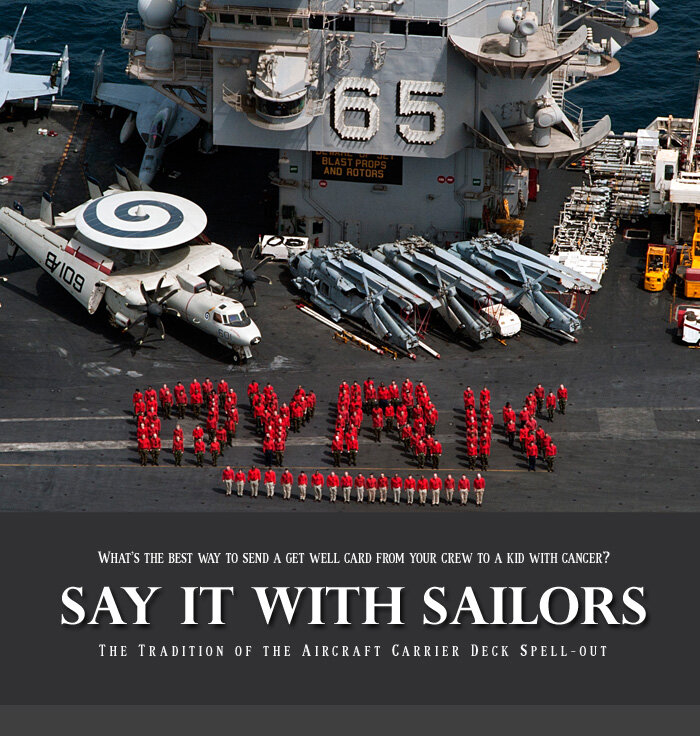


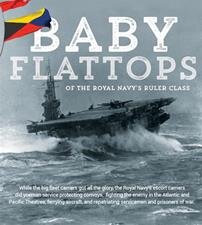



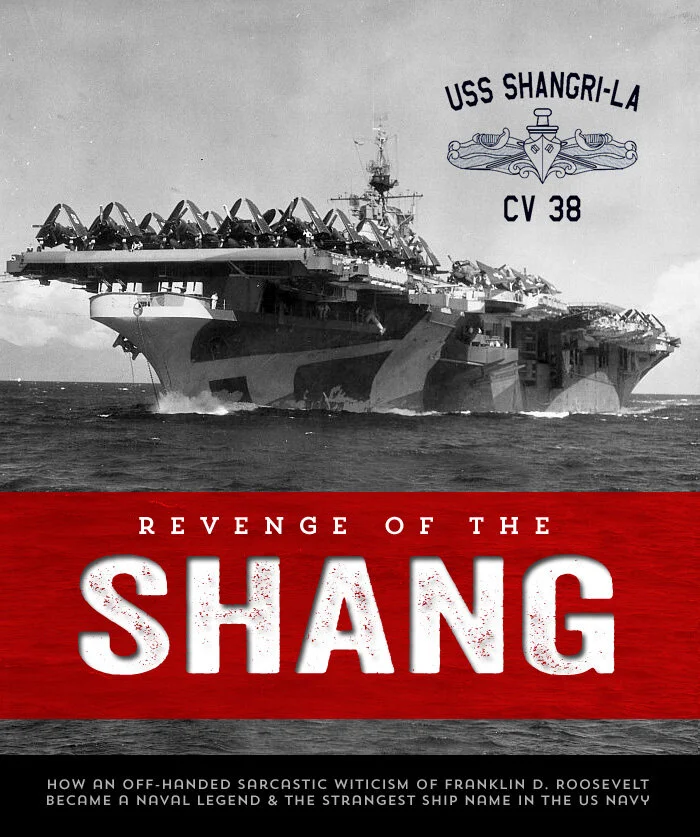
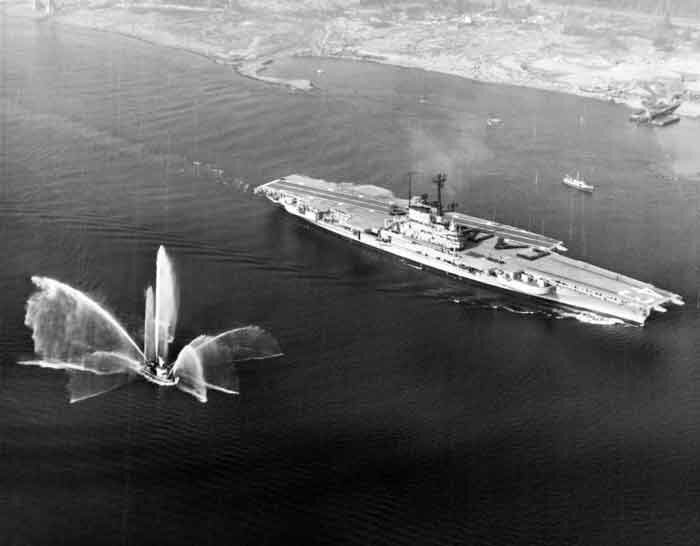



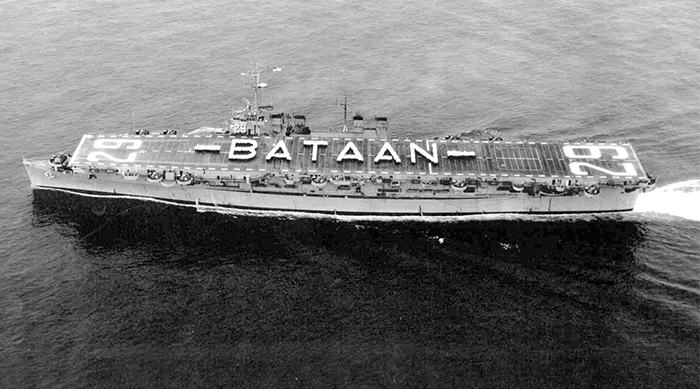





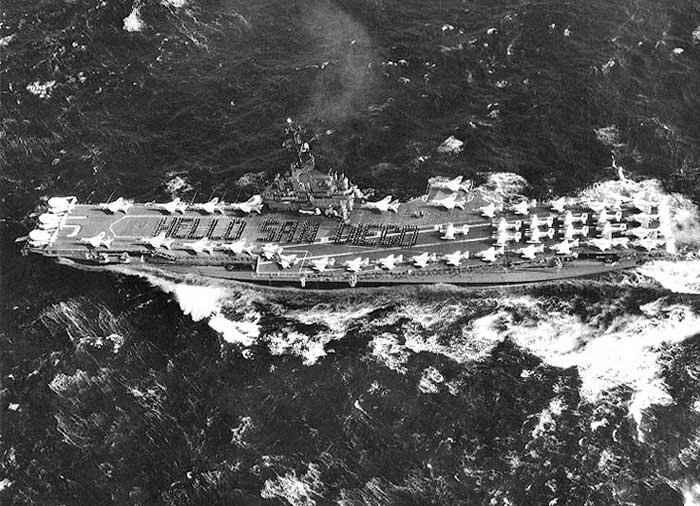











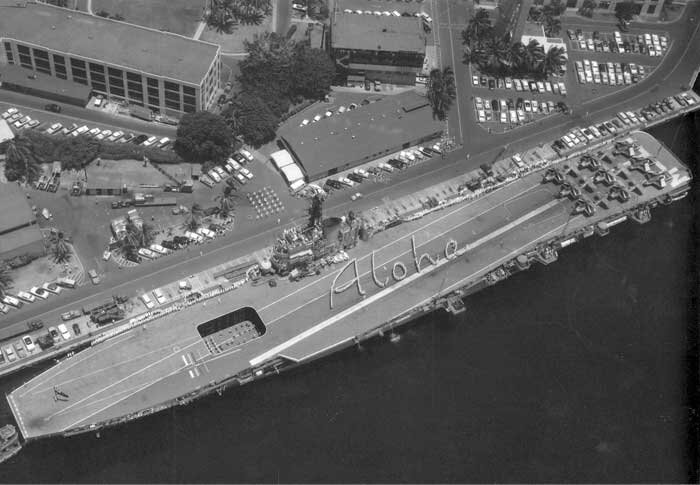




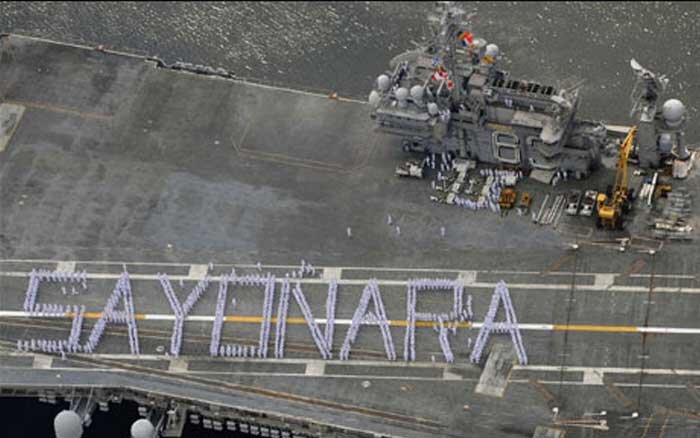





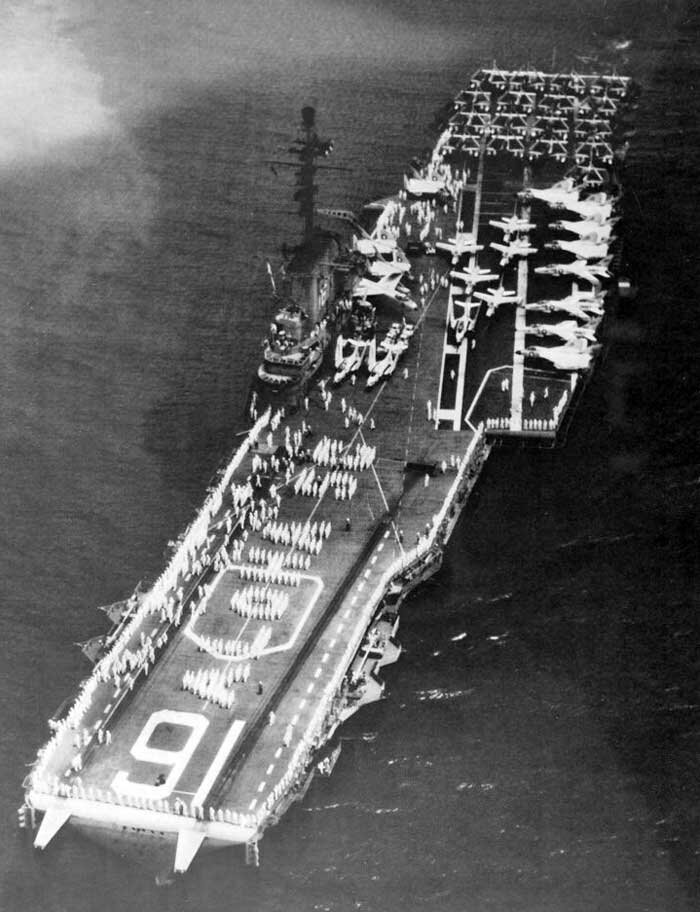




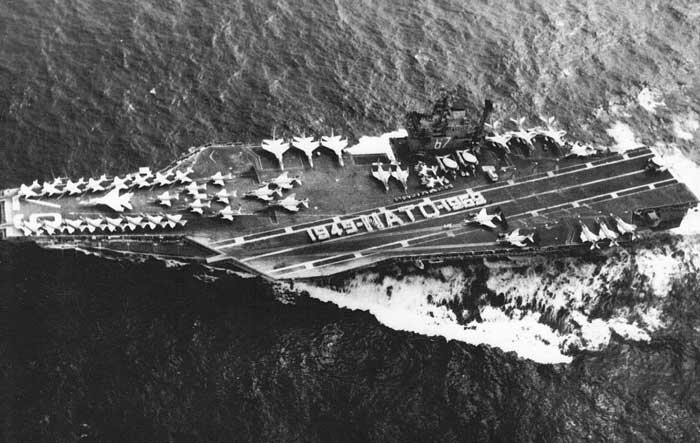







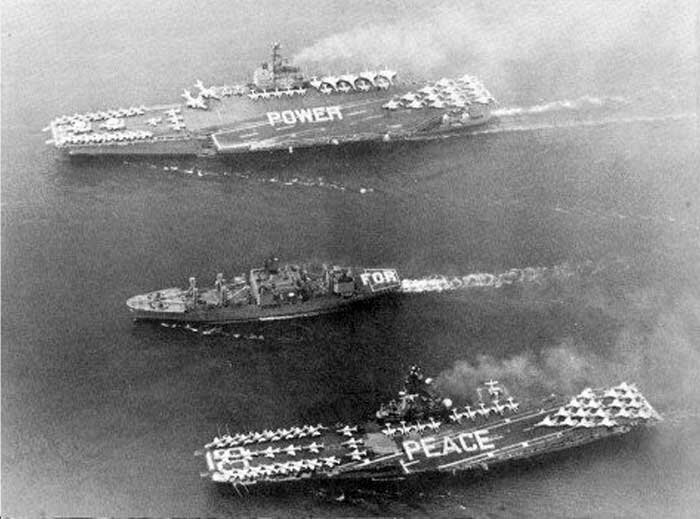




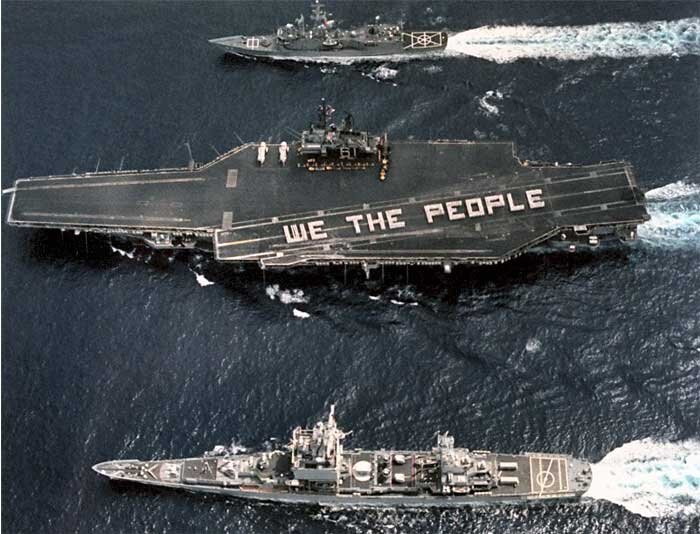

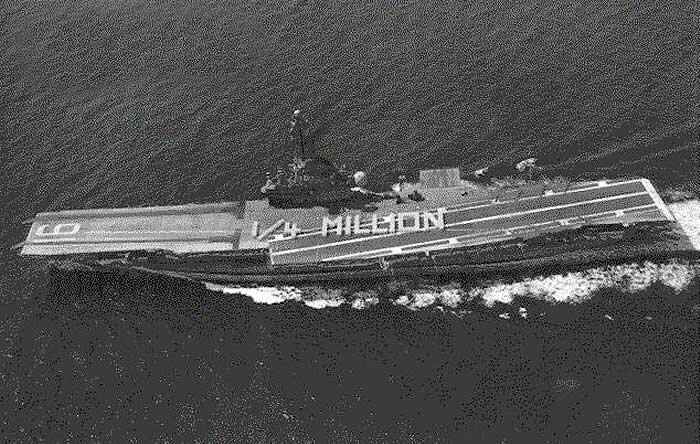



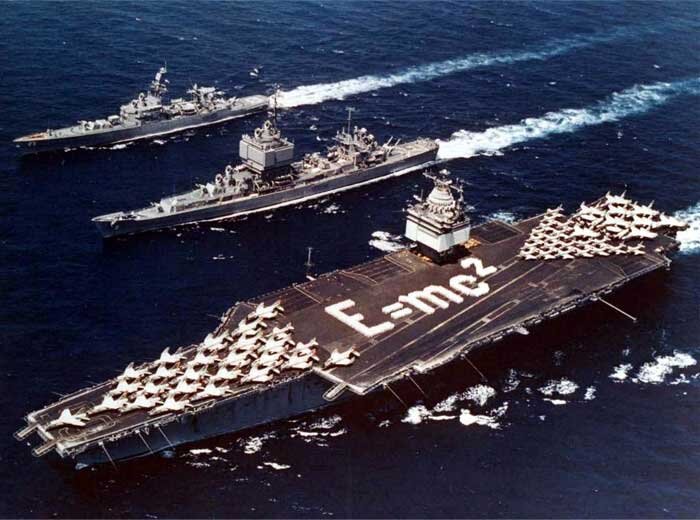












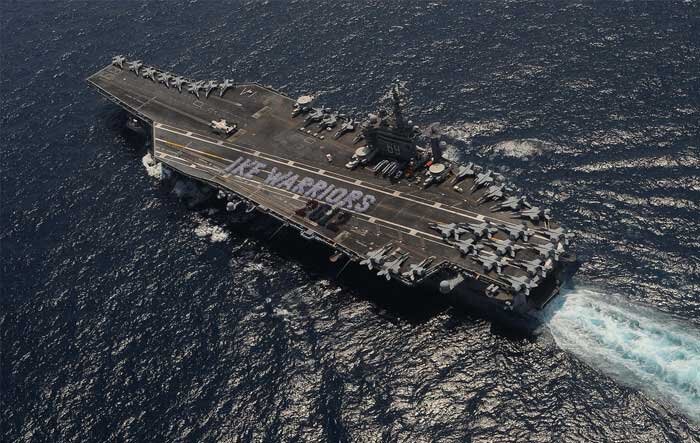



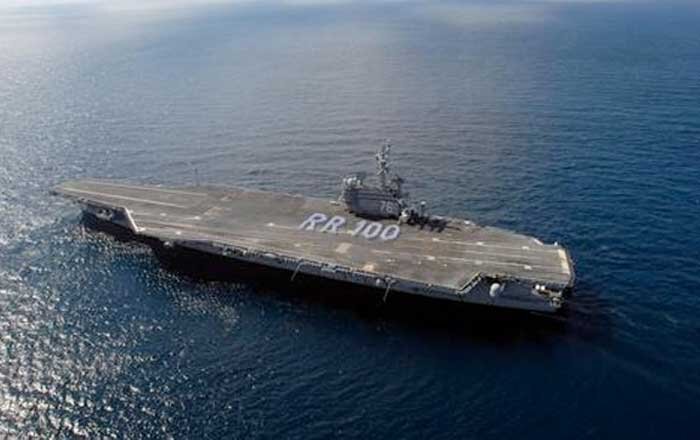





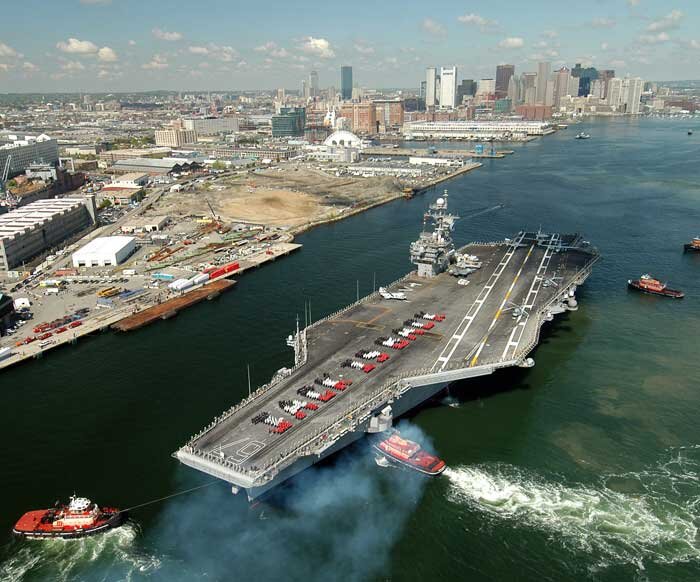










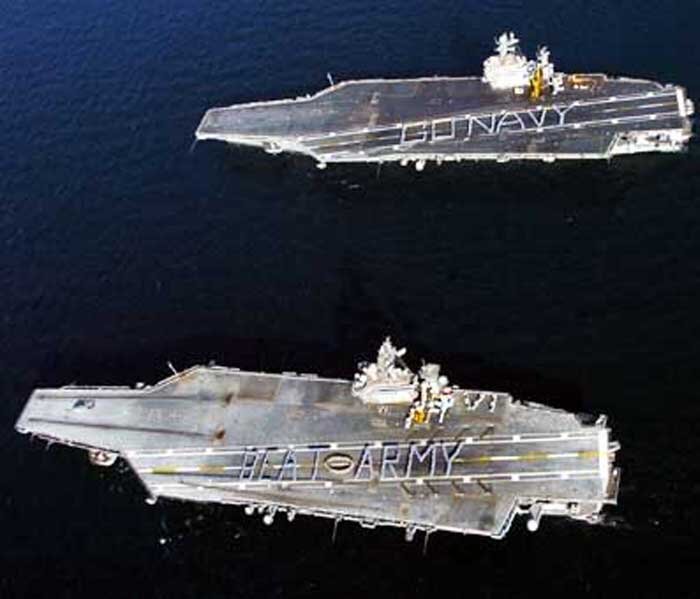







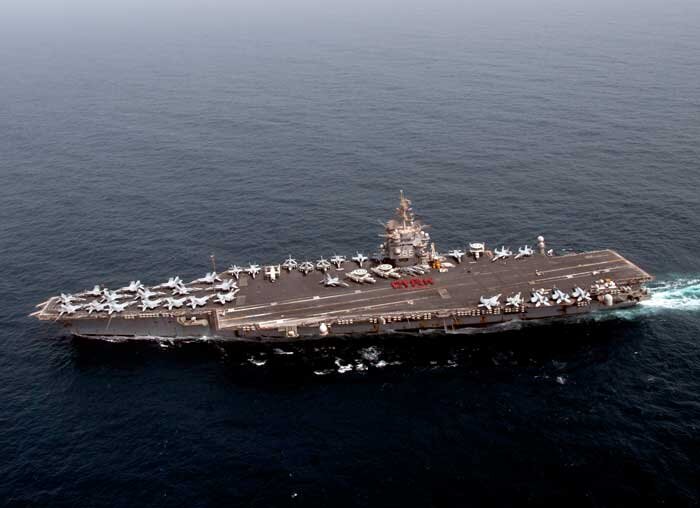





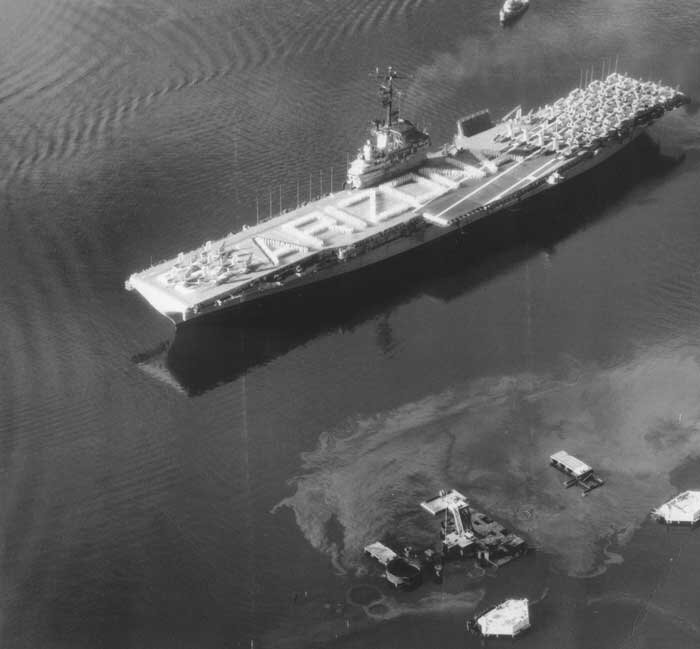







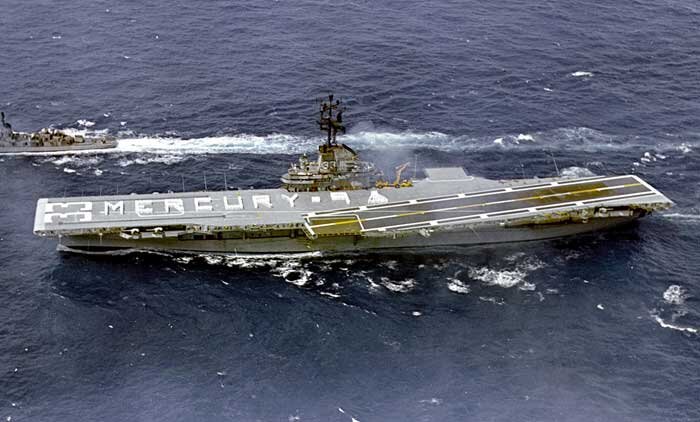




![It’s always a good thing to conduct a flight deck spell-out, don’t get me wrong. But, some are well done, and some are just plain messy. While this spell-out on the USS Abraham Lincoln looks good at a distance and when you are distracted by the rainbow, the next photo shows us that it may not be the finest spell-out. The US Navy press release with the photo sets the scene: PACIFIC OCEAN (Sept. 27, 2008) The aircraft carrier USS Abraham Lincoln (CVN 72) passes under a rainbow as sailors from Lincoln and Carrier Air Wing (CVW) 2 participate in a “flight deck spell-out” [of “ABE CVW2”–Ed] while transiting the Pacific Ocean. The Abraham Lincoln Strike Group is on a scheduled deployment in the US 7th Fleet area of responsibility. Photo: US Navy](https://images.squarespace-cdn.com/content/v1/607892d0460d6f7768d704ef/1628385892084-S8K7IWAOQ6B19GOKB8BK/5D276E0F-448B-4327-9EB1-E50902C1CFF0.jpeg)





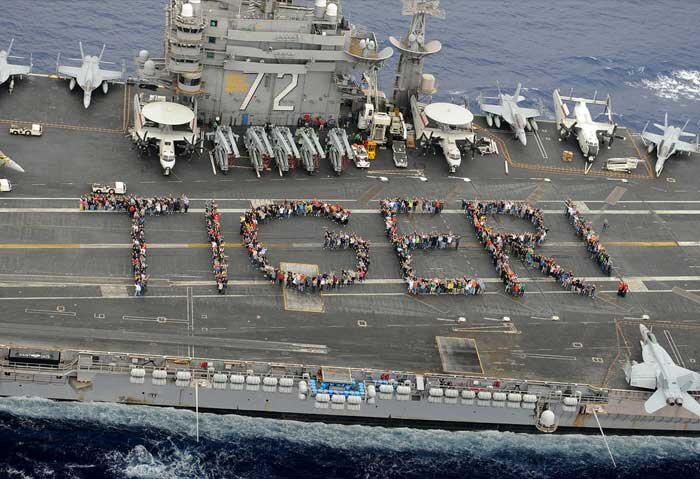

![The caption accompanying this photograph from the US Navy reads “GULF OF ALASKA (June 24, 2009) Weapons department personnel [Ordnancemen] spell-out “John Finn” on the flight deck of the aircraft carrier USS John C. Stennis (CVN 74) to commemorate the 100th birthday of Medal of Honor recipient Naval Aviation Ordnanceman John Finn. John C. Stennis is participating in Northern Edge 2009, a joint exercise focusing on detecting and tracking units at sea, in the air and on land.” John William Finn was a sailor in the United States Navy who, as a chief petty officer, received the United States military’s highest decoration, the Medal of Honor, for his actions during the attack on Pearl Harbor. As Finn was an ordnanceman himself, it is fitting that the red shirts (ordnancemen) did the spell-out on Stennis. Photo: US Navy](https://images.squarespace-cdn.com/content/v1/607892d0460d6f7768d704ef/1628386219061-86R36DP8E8KCM2WMPSCW/68DF6DD9-085F-4142-9748-54128016D42C.jpeg)




